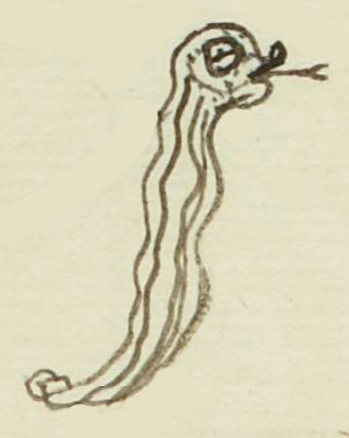Ecacoacatl (MH763v)
This black-line drawing of the simplex glyph for the personal name, title, or ethnicity, Ecacoacatl (perhaps “Whirlwind,” suggested by James Lockhart in The Nahuas, 1992, 120) is attested here as a man’s name. The glyph shows a vertical serpent (coatl) that is striped on the body and spotted on the head. It has a large eye and a small, protruding, bifurcated tongue. Above the tongue, at what might be the site of an upper lip, there is another protrusion; perhaps this is the buccal mask that relates to the divine force of wind (Ehecatl) being able to spray wind around the earth. The final part of the name (-catl, having to do with affiliation to a place but also found in some religious titles) is not shown visually.
Stephanie Wood
The Eca- or Eheca- start to this name is represented more directly in the example of this name from folio 485 verso (see below). A great many glyphs in this collection start with Eca- when one might expect Eheca-. We are preserving the proclivity of the gloss for Eca-, while also pointing to the likelihood of an unintentional oral abbreviation of Eheca- to Eca-. The gloss here does not reduplicate the first syllable in Ecatl, a common personal name, but, just as with those names, this is likely a reference to Ehecatl, the divine force of wind and a day sign in the calendar. The serpent adds a significant meaning, of course, and the -catl suffix may refer to an ethnicity, a person from a specific place, and substituting for -co.
Stephanie Wood
1560
Jeff Haskett-Wood
wind, viento, aliento, aire, serpents, snakes, serpientes, víboras, nombres de deidades, nombres de hombres, cohuatl

eca(tl), air/breath, https://nahuatl.wired-humanities.org/content/ecatl
eheca(tl), wind or the divine force associated with it, https://nahuatl.wired-humanities.org/content/ehecatl
coa(tl), snake/serpent, https://nahuatl.wired-humanities.org/content/coatl
-catl (an affiliation suffix, https://nahuatl.wired-humanities.org/content/catl
posiblemente, Remolino
Stephanie Wood
Matrícula de Huexotzinco, folio 763v, World Digital Library, https://www.loc.gov/resource/gdcwdl.wdl_15282/?sp=605&st=image
This manuscript is hosted by the Library of Congress and the World Digital Library; used here with the Creative Commons, “Attribution-NonCommercial-ShareAlike 3.0 License” (CC-BY-NC-SAq 3.0).


